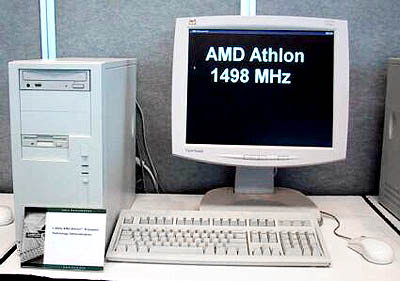Gisteren heb je in deze nieuwsposting kunnen lezen dat AMD op de Comdex een 1,5GHz Palomino systeem demonstreert. Volgens Dean heeft AMD de overclocking-truckendoos ongebruikt kunnen laten om deze kloksnelheid te bereiken: het Palomino systeem is 100% puur en maakt gebruik van een standaard power supply, een standaard Vcore voltage en standaard cooling. Hoewel het nooit door AMD is bevestigd, zijn er sterke indicaties dat de nieuwe Mustang core extra pipeline stages heeft. Dit maakt het eenvoudiger om hogere kloksnelheden te bereiken.
 |
Wat betreft de dood van de Athlon Ultra herhaalt RWT de argumenten van AMD over een gebrek aan belangstelling voor een large-cache versie van de Mustang core. Op zich is dit niet onbegrijpelijk omdat de large-cache Xeons ten opzichte van de PII en PIII nooit veel snelheidsvoordeel hebben laten zien. Het verschil is groter in 2-way en 4-way systemen waar de grotere L2 cache de bandbreedte bottleneck van de gedeelde FSB deels kunnen compenseren. Dit probleem is veel kleiner bij de 760MP chipset, omdat die gebruik maakt van DDR SDRAM en een point-to-point bus naar de processors:
AMD has indicated that they were seeing very little interest in a large L2 cache processor, since they have not yet penetrated that market to any degree. Instead, they will be focusing upon the volume SMP market with the Palomino and the AMD 760MP chipset in the first half of 2001. If any demand appears for an Athlon processor with a larger cache, and the customer is willing to pay for it - AMD can and will produce it
![]() Chipsets
Chipsets
De Comdex stand van AMD werd verder opgevrolijkt met een close-box demo van 3DMax op een dual 760MP/Palomino systeem. Als we AMD mogen geloven dan is de ontwikkeling van de 760MP feitelijk voltooid en wordt er met de release gewacht tot DDR SDRAM door de markt is geaccepteerd. De eventuele technische problemen die hierbij aan het licht komen, kunnen in de komende maanden dan alsnog gefixt worden: [/break] While some may tout this as proof that AMD is not capable of developing the technology quickly enough, it can also be seen as proof that AMD is being much smarter in their development efforts. No longer playing catch up to Intel on the desktop, and soon in the mobile space, AMD can now take their time to ensure they have stable products, which will be necessary to woo corporate usage in any volume
 |
Dean Kent kreeg van Acer Labs te horen dat er geen troubles zijn met de MAGiK1 chipset, zoals eerder werd gespeculeerd. Iwill heeft aangegeven dat hun KA266-R mobo met MAGiK1 chipset in de eerste week van december gereleased wordt. Hoewel nog enkele andere fabrikanten een MAGiK1 plankje lieten zien, is het duidelijk dat de AMD 760 chipset veruit de voorkeur geniet bij de mobofabrikanten: [/break] At this time, it is probably not appropriate to be talking about rumors regarding chipset bugs, as there are several vendors who do not believe them. Suffice it to say, however, that there are some manufacturers with reservations about the chipset. The real situation should be revealed as we approach December. What is obvious here, however, is that there is a high degree of cooperation between ALi, AMD and Micron in making sure that the DDR enablement is successful.
![]() Moederborden
Moederborden
Op moederbord-gebied blijkt de meeste aandacht uit te gaan naar DDR SDRAM en niet naar de voor volgende week geplande release van de Pentium 4. Vrijwel alle mobofabrikanten demonstreren DDR mobo's. Sommigen hebben zelfs aangeven met de release van een P4 plankje te wachten tot Intel of VIA een (DDR) SDRAM chipsets voor de Pentium 4 hebben uitgebracht. De grootste belemmering voor de release van AMD 760 mobo's is momenteel het gebrek aan 266MHz FSB Thunderbirds. Micron zegt in ieder geval dat zij klaar zijn om de productie van DDR chips omhoog te trappen wanneer de markt daar om vraagt: [/break] Though there is much interest in releasing motherboards ASAP, the main holdup appears to be the AMD processors that will run at 266MHz FSB. Though it is possible to run todays Athlons with DDR, they will be limited to 200MHz (PC1600) speeds, and most believe that this is not a compelling reason for most customers to upgrade. Micron has indicated they are ready to produce DDR in significant volumes as soon as they see demand from the market.

